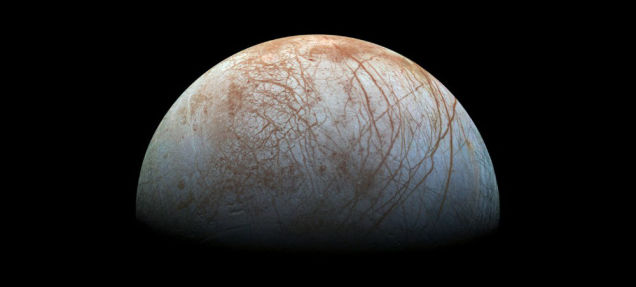With massive oceans buried under 6km of ice, Jupiter’s moon Europa has long been a dream destination for astronomers. It’s possible that those oceans, warmed by undersea volcanoes, could harbour microbial life. NASA’s wanted a closer look for 15 years, and now they’re getting it.
In NASA’s 2016 budget, the plan to explore Europa received a huge $US255 million commitment over the course of five years, which is a more resolute green light then last year’s $US100 million allocation to begin investigation into such a mission. According to NASA, “this is “the first time, the budget supports the formulation and development of a Europa Mission, allowing NASA to begin project formulation, Phase A.” So yeah, we’re going to Hoth, basically.
Although plans have previously called for robot explorers that would drill into Europa’s icy exterior, NASA’s proposed budget suggests sending a probe in an elliptical orbit around Jupiter, similar to Saturn’s Cassini spacecraft. The current front-running concept, Europa Clipper, would fly by Europa 45 times in just a 3.5-year span. This would give scientists unprecedented information about the moon (including what the hell those red streaks are), which has been a cosmic mystery ever since the Galileo orbiter discovered that Europa might have oceans in the 1990s.
So exactly what kind of spacecraft are we talking about here? Since this plan won’t be blasting off into space for another decade, the payload right now is still under refinement. One thing is for certain — It will need to be incredibly robust in order to withstand Jupiter’s radiation belt. Here’s what NASA has put on its grocery list of equipment:
The possible payload of science instruments under consideration includes radar to penetrate the frozen crust and determine the thickness of the ice shell, an infrared spectrometer to investigate the composition of Europa’s surface materials, a topographic camera for high-resolution imaging of surface features, and an ion and neutral mass spectrometer to analyse the moon’s trace atmosphere during flybys.
Sara Susca, the payload systems engineer for the Europa Clipper told Discovery News that the craft will have something called a “vault”, essentially heavy shielding to protect the craft’s “brains” from Jupiter’s radiation. Susca also says that the Clipper will be solar-powered and that means two massive solar arrays (8.8m by 1.2m) flanking the body of the spacecraft.
Also, Jupiter is pretty far away — about an eight-year trip using the gravity assist method. Luckily NASA’s in-development space launch system could cut that travel time in half.
Seems like after 15 years unsatiated science interest in Europa, we’re finally going to go see what all the fuss is about. Read more about the spacecraft plans via NASA.
